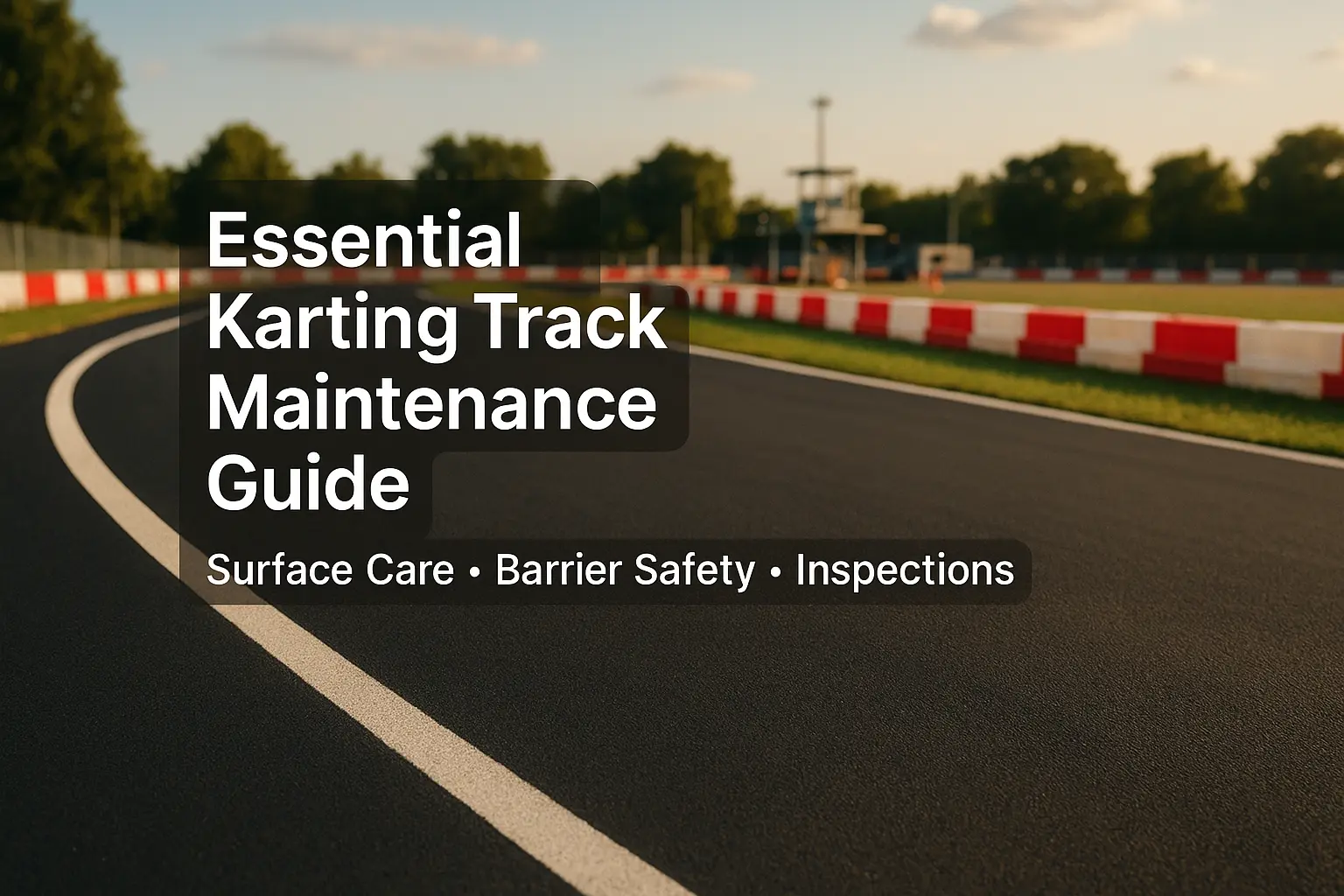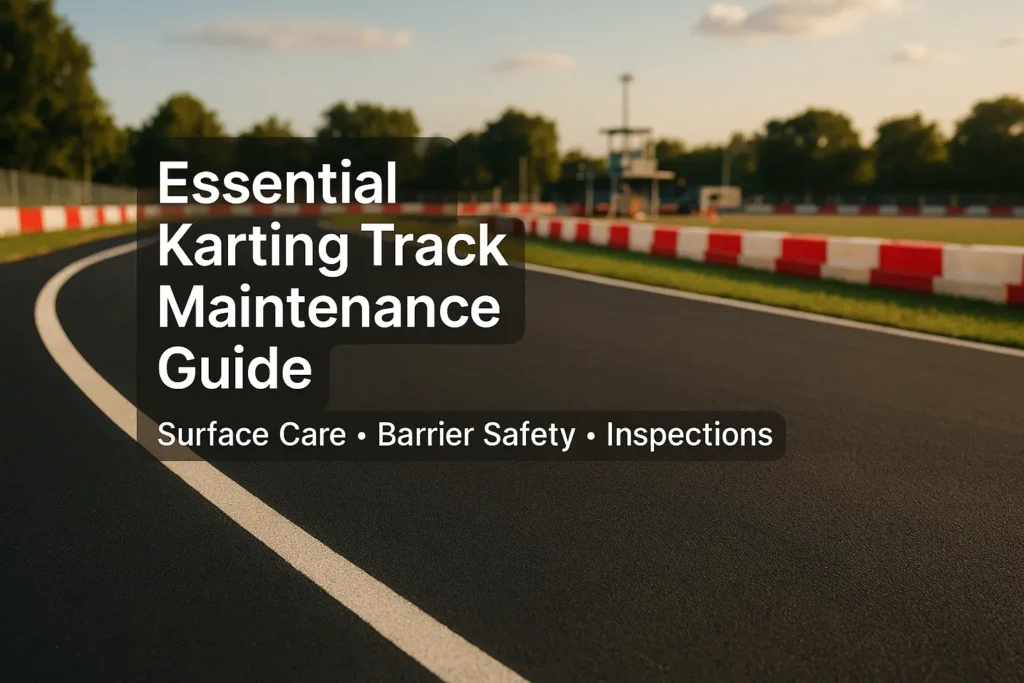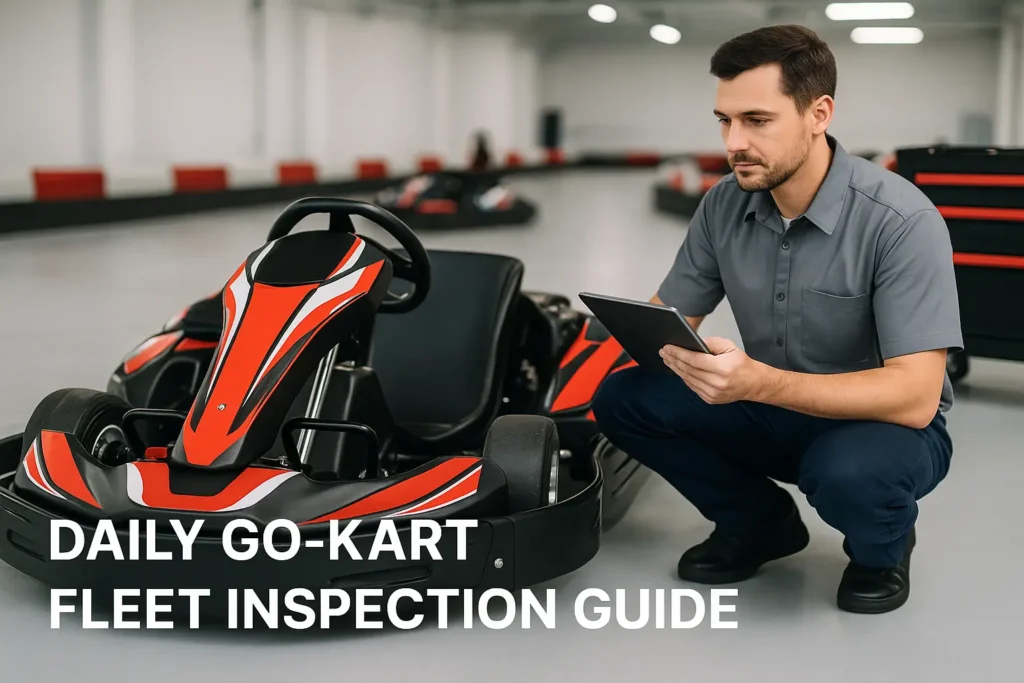Karting track maintenance isn’t just about aesthetics—it’s the foundation of safe, competitive racing. A well-maintained track protects drivers, extends equipment lifespan, and ensures consistent performance. Whether you operate a recreational facility or a competitive racing circuit, understanding the three pillars of track maintenance—surface care, barrier integrity, and safety checks—is crucial for success.
Why Track Maintenance Matters
Before diving into specific maintenance procedures, consider this: a single overlooked crack in the track surface or a compromised barrier section can lead to serious accidents. Beyond safety concerns, poor maintenance directly impacts the racing experience. Uneven surfaces affect kart handling, deteriorated barriers create psychological barriers for drivers, and neglected safety systems can halt operations entirely.
Regular maintenance also protects your investment. Addressing minor issues early prevents costly repairs later. A proactive approach keeps your facility operational, maintains customer satisfaction, and builds a reputation for quality that attracts serious racers and casual enthusiasts alike.
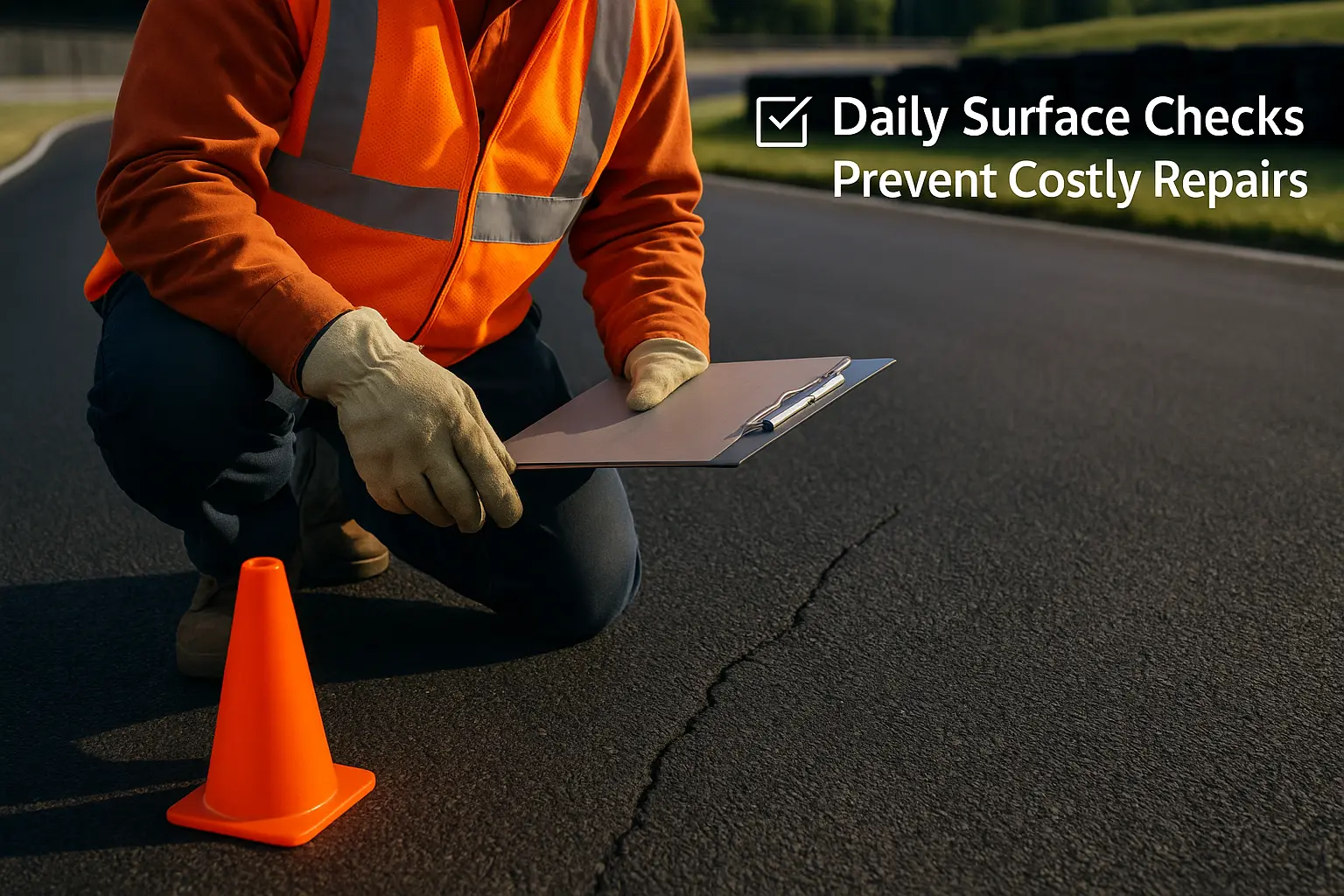
Track Surface Care: The Foundation of Performance
Daily Surface Inspections
Start each operating day with a thorough visual inspection. Walk the entire track perimeter, looking for fresh cracks, surface deterioration, or debris accumulation. Pay special attention to high-stress areas like tight corners and braking zones where surface wear accelerates.
Weather creates specific challenges. After rain, check for standing water that indicates drainage problems. Following extreme heat, look for surface expansion damage or softened asphalt. Winter months may reveal freeze-thaw damage that wasn’t visible during warmer periods.
Debris removal goes beyond simple sweeping. Collect fallen leaves before they decompose and create slippery patches. Remove stones or gravel tracked onto the surface immediately—these become projectiles at racing speeds. Oil spots require prompt treatment with appropriate absorbents to prevent slick conditions.
Surface Cleaning Techniques
Different track surfaces demand different cleaning approaches. Asphalt tracks benefit from regular power washing to remove rubber buildup, though excessive pressure can damage older surfaces. Concrete tracks typically handle aggressive cleaning better but may develop a slippery residue if certain detergents are used.
Rubber accumulation changes track characteristics over time. While some rubber provides additional grip, excessive buildup creates inconsistent surfaces. Schedule periodic deep cleaning to restore original surface properties. This process typically involves specialized equipment and should be planned during off-hours.
Oil spills require immediate attention. Spread absorbent material immediately, let it sit for the recommended time, then sweep and dispose of properly. Follow up with a degreasing agent suitable for your surface type. Never leave oil stains untreated—they create dangerous low-grip zones that persist through multiple sessions.
Long-term Surface Management
Track resurfacing represents a significant investment, making it essential to maximize surface lifespan. Most tracks require complete resurfacing every 7-10 years, depending on usage intensity and climate conditions. However, proactive maintenance can extend this timeline considerably.
Monitor grip levels consistently. Drivers will notice changes before they’re visually apparent. Decreased lap times, increased sliding, or driver complaints about grip all signal surface degradation. Keep detailed records of these observations to identify patterns and predict maintenance needs.
Drainage systems often receive insufficient attention until problems become severe. Clean drainage channels quarterly, removing accumulated sediment and debris. Check that water flows freely to designated collection points. Poor drainage accelerates surface breakdown and creates hazardous wet patches during rain.
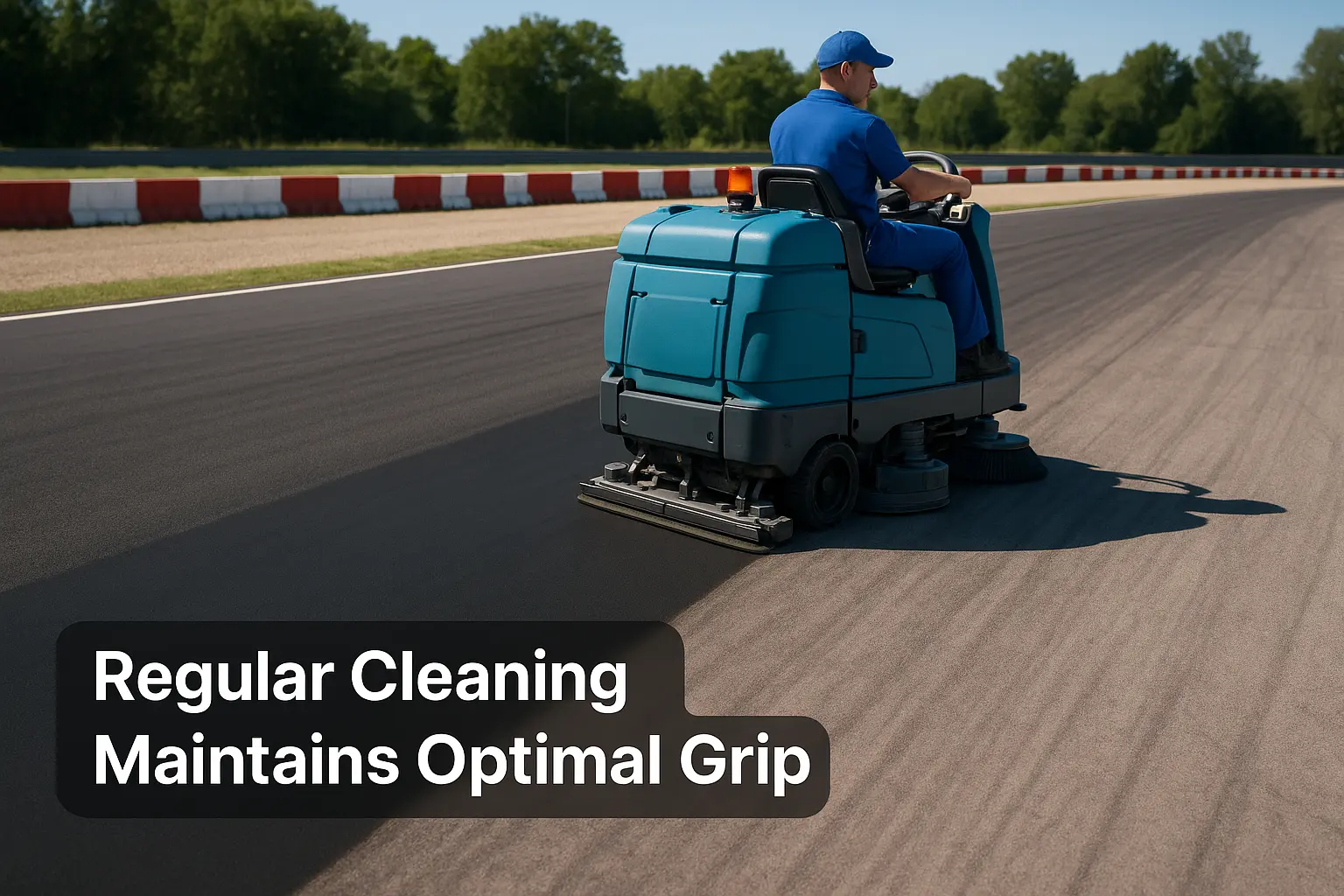
Barrier Integrity Management
Understanding Barrier Functions
Barriers serve multiple purposes beyond simply stopping karts. They define track boundaries, absorb impact energy, prevent secondary collisions, and protect spectators and equipment. Each barrier type has specific maintenance requirements based on its design and materials.
Regular Barrier Inspections
Conduct barrier inspections weekly at minimum, with daily checks after incidents. Look for obvious impact damage—dents, cracks, or displacement. Even minor contact can compromise structural integrity over time.
Connection points deserve special attention. Barriers typically link together in sections, and these joints represent potential weak points. Verify that fasteners remain tight, connection hardware hasn’t corroded, and adjacent sections maintain proper alignment. A barrier that separates during impact fails its primary purpose.
Check barrier positioning carefully. Barriers should maintain consistent distance from the track edge. Sections that have shifted create irregular racing lines and potential trap points. Measure barrier height regularly—settling or foundation issues can lower barriers below safe specifications.
Tire Barrier Maintenance
Tire barriers offer excellent impact absorption and cost-effectiveness, making them popular choices. However, they require consistent upkeep. Inspect tire condition regularly—UV exposure degrades rubber over time, creating brittle tires that don’t absorb impacts properly.
Verify tire connections remain secure. Whether using cables, bolts, or strapping, connection integrity determines barrier effectiveness. Replace worn connectors immediately. Check that tires remain properly filled or packed—deflated or loose tires reduce protective capability.
Clean tire barriers periodically to prevent moisture accumulation that promotes deterioration. Remove vegetation growing between tires—roots can displace sections and create gaps. Paint or treat tires to reduce UV damage in high-sun environments.
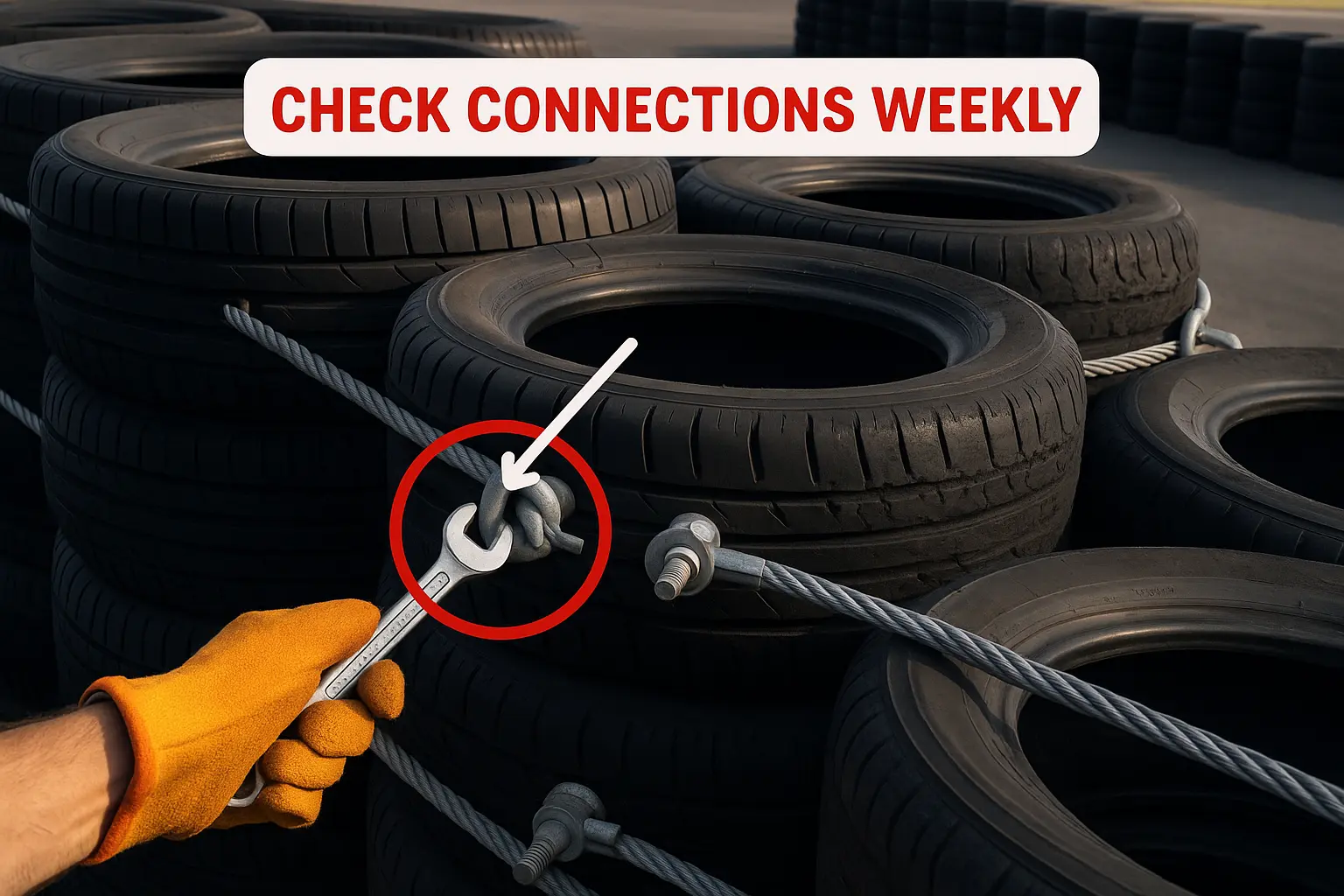
Plastic and Composite Barriers
Modern plastic barriers provide consistent performance and weather resistance. Inspect for cracks, especially around mounting points where stress concentrates. UV damage appears as surface chalking or color fading—while cosmetic initially, it indicates material degradation that eventually affects strength.
Check that barriers remain flexible. Tap sections with a rubber mallet—they should flex and return to position. Brittle barriers that crack or chip have reached replacement age. Verify that interlocking mechanisms function properly and haven’t warped from repeated impacts.
Mounting systems require regular attention. Ensure ground anchors remain secure and haven’t loosened due to soil movement or impact vibrations. Tighten any loose fasteners and replace damaged mounting hardware immediately.
Steel Guardrail Systems
Steel barriers provide maximum protection but demand vigilant maintenance. Inspect for rust, especially at ground level where moisture accumulates. Treat surface rust immediately with appropriate primers and paint. Structural rust requires professional assessment and potential replacement.
Check rail continuity—gaps between sections create dangerous catch points. Verify that posts remain vertical and firmly anchored. Impact damage may not be immediately obvious—look for bent posts, deformed rails, or compromised foundations that could fail during subsequent impacts.
Pay attention to rail end treatments. Improperly finished rail ends create spear-like hazards. Ensure end caps remain in place and terminals are properly installed according to safety standards.
Comprehensive Safety Checks
Track Perimeter Safety
Runoff areas provide critical safety margins when drivers leave the racing surface. Inspect runoff zones for debris, holes, or surface irregularities that could flip a kart or cause injury. Maintain consistent surface conditions—avoid transitions from smooth asphalt to rough gravel that can destabilize karts.
Keep runoff areas clear of equipment, barriers, or materials. What seems like a convenient storage spot becomes a collision hazard during an incident. Mark permanent obstacles clearly and ensure adequate clearance from the racing line.

Visibility and Signage
Proper signage communicates critical information to drivers. Verify that all signs remain legible, properly positioned, and securely mounted. Replace faded or damaged signs immediately. Check that warning signs for dangerous sections are appropriately placed and visible from adequate distances.
Track lighting enables extended operating hours but requires regular maintenance. Test all lighting circuits weekly, replacing failed bulbs immediately. Clean light fixtures quarterly to maintain brightness levels. Verify that emergency lighting systems function independently of main power.
Corner worker stations need clear sightlines and weatherproof construction. Ensure communication systems work reliably and workers have necessary safety equipment readily accessible.
Electrical and Technical Systems
Modern tracks depend on electronic systems for timing, scoring, and safety management. Test timing loops regularly to ensure accurate lap recording. Verify that transponder readers detect signals consistently across the track width.
Emergency stop systems represent your most critical safety feature. Test these systems weekly following manufacturer protocols. Ensure that activation triggers are accessible from multiple track positions and that all staff know activation procedures.
Communication equipment enables coordination during incidents. Test radios, intercoms, and public address systems regularly. Keep backup batteries charged and replace aging equipment before failures occur.
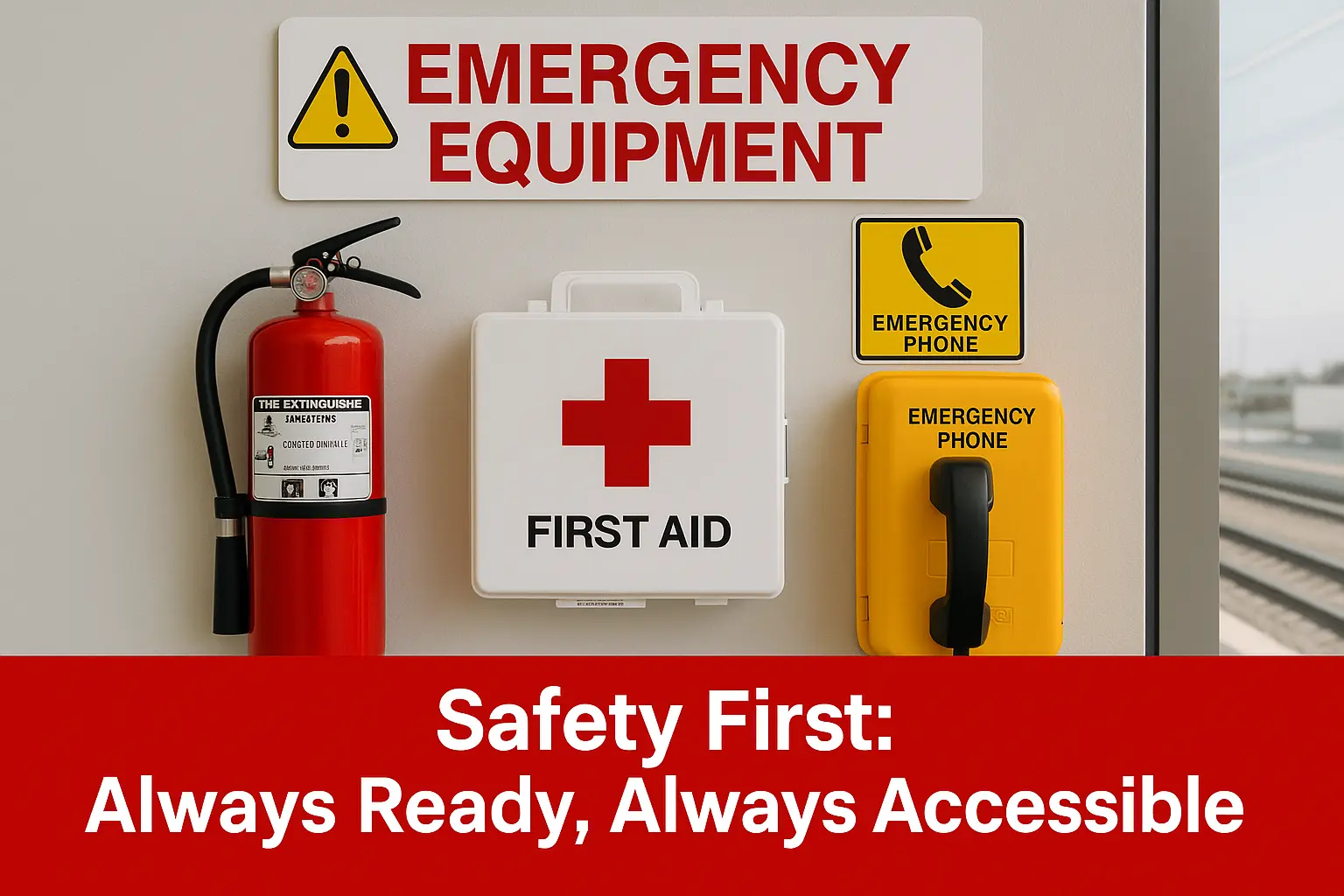
Emergency Preparedness
Fire safety equipment must be immediately accessible and properly maintained. Inspect fire extinguishers monthly, verifying pressure levels and accessibility. Replace expired units according to regulations. Ensure staff knows extinguisher locations and proper use procedures.
First aid stations should contain current supplies and be clearly marked. Check supplies monthly, replacing expired medications and depleted materials. Consider the specific injuries common in karting when stocking stations—road rash treatment supplies, ice packs, and splinting materials are frequently needed.
Maintain clear emergency access routes at all times. Emergency vehicles must reach any track location quickly. Mark routes clearly, keep them obstacle-free, and ensure gates remain unlocked during operating hours.
Creating Effective Maintenance Schedules
Daily Tasks
Begin each operating day with a focused inspection routine. Walk the track surface looking for new damage or hazards. Check barriers for overnight vandalism or weather damage. Test emergency systems and verify communication equipment functionality. This 30-minute investment prevents most operational problems.
Weekly Requirements
Schedule comprehensive inspections weekly when usage patterns allow. Thoroughly examine barrier connections, check all signage, and test backup systems. Clean drainage channels and remove accumulated debris from runoff areas. Document findings and address identified issues promptly.
Monthly Maintenance
Monthly maintenance includes deeper cleaning, detailed barrier inspections, and system testing. Power wash track surfaces, deep clean tire barriers, and inspect electrical systems thoroughly. Review maintenance logs to identify developing patterns that might indicate larger problems.
Seasonal Considerations
Different seasons create specific challenges. Spring inspections should focus on winter damage—freeze-thaw cycles, water infiltration, and storm debris. Summer maintenance emphasizes UV damage, drainage capacity before storm season, and heat-related surface issues.
Fall preparations include leaf management systems and preparing for winter weather. Winter maintenance varies by climate but generally involves protecting systems from freezing, monitoring snow and ice damage, and planning spring repairs.
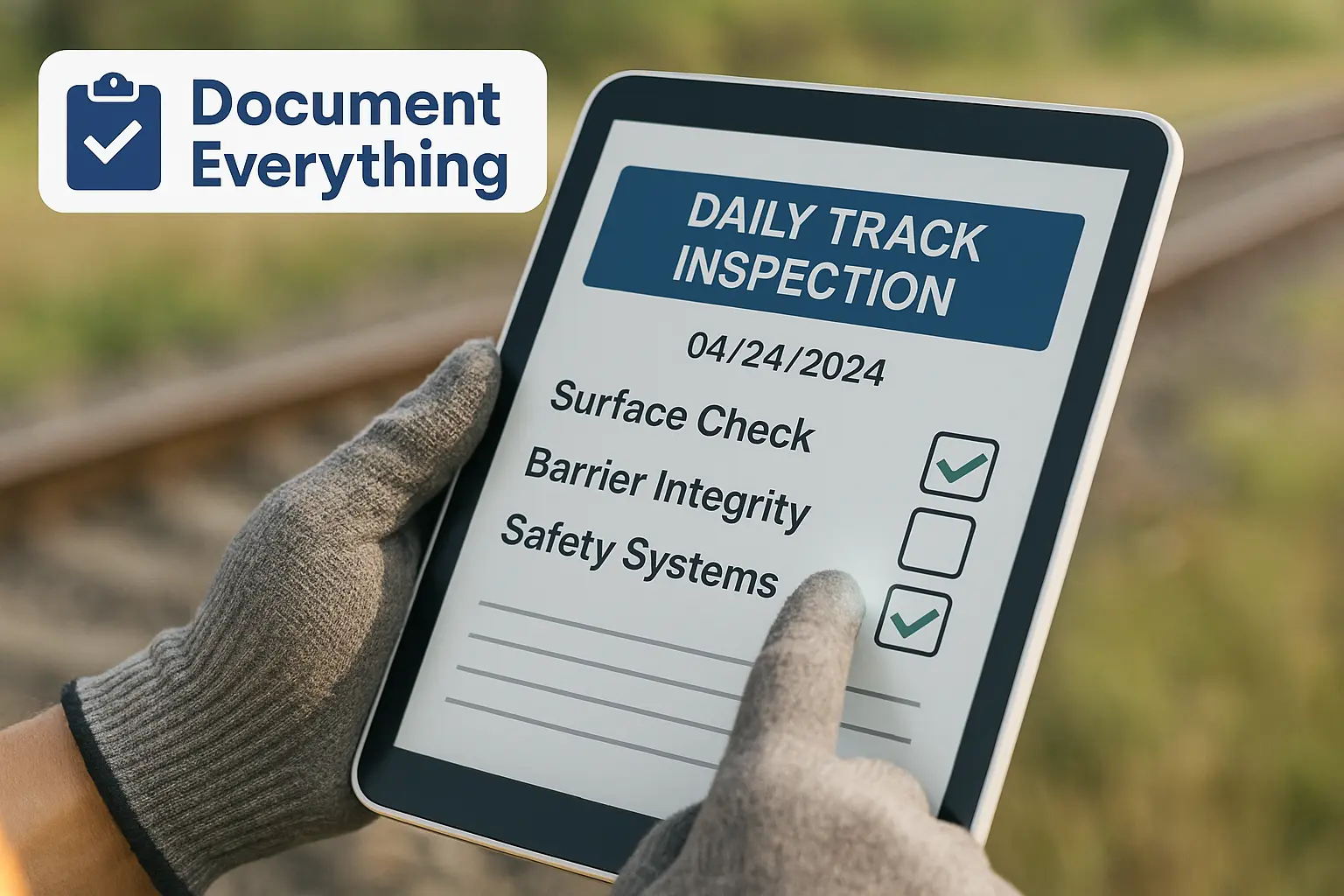
Documentation Best Practices
Comprehensive record-keeping transforms maintenance from reactive to predictive. Document every inspection, repair, and incident. Modern facilities benefit from digital systems that enable trend analysis and automated scheduling.
Create detailed checklists for each maintenance category. Standardized checklists ensure consistency across different staff members and prevent overlooked items. Include photo documentation for significant damage or completed repairs—visual records provide valuable context for future decisions.
Track maintenance costs and correlate them with usage patterns. This data helps predict budgeting needs and identify cost-effective timing for major projects. Understanding which areas require frequent attention may indicate design issues that should be addressed during renovations.
Maintain compliance documentation meticulously. Safety inspections, equipment certifications, and regulatory compliance records protect your facility legally and demonstrate professionalism to customers and insurers.
Choosing Quality Equipment Partners
When it’s time to upgrade or expand your facility, selecting reliable equipment partners makes tremendous difference. Minye Fun specializes in electric go-karts and comprehensive karting solutions designed with maintenance efficiency in mind. Their electric karts eliminate many traditional maintenance headaches—no oil changes, reduced brake wear, and simpler drivetrain servicing mean more track time and lower operating costs.
Electric karts from providers like Minye Fun also reduce track maintenance burden. Without fuel spills or exhaust residue, surfaces stay cleaner longer. Reduced noise levels improve relationships with neighboring properties. The regenerative braking systems create less brake dust and surface contamination than traditional karts.
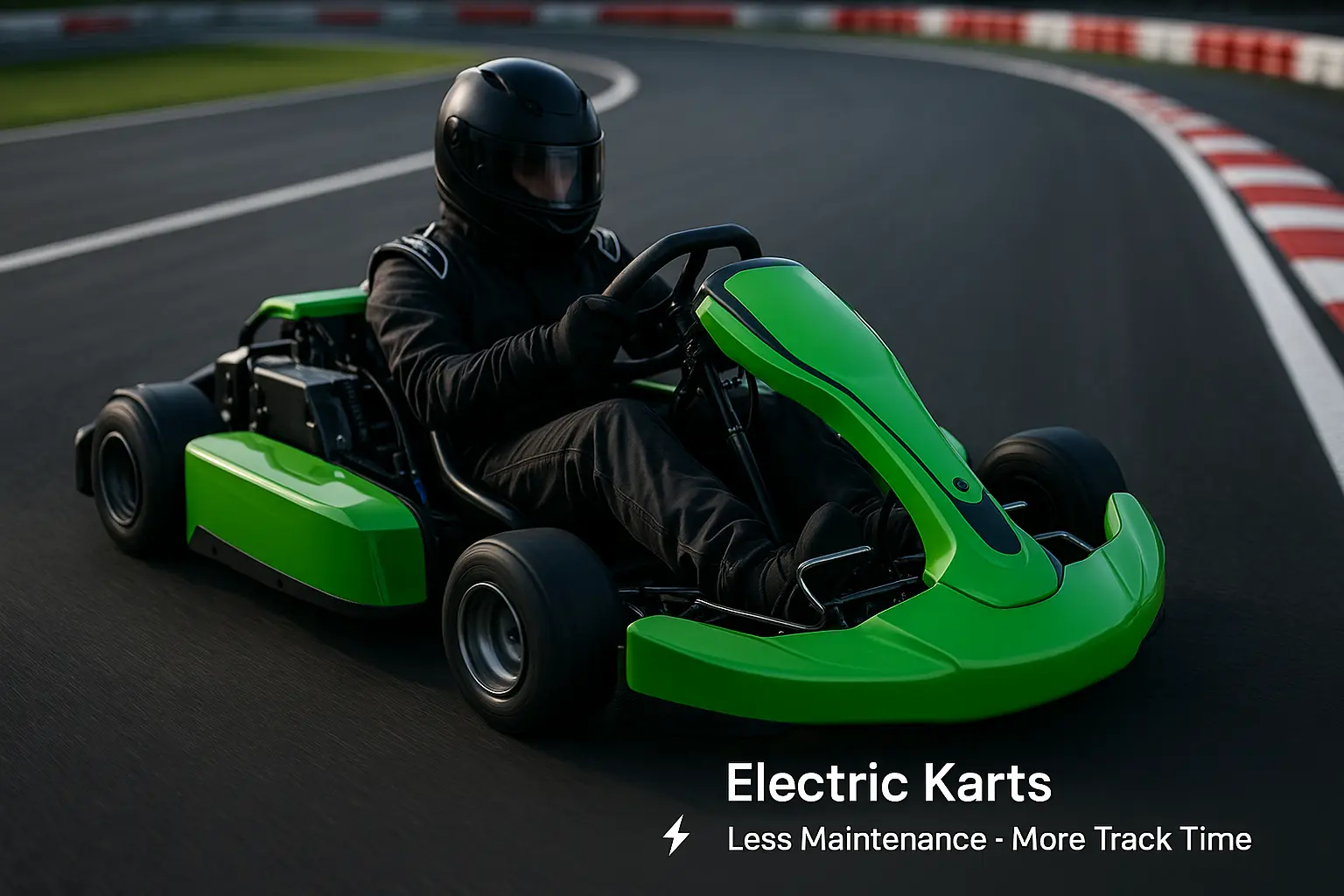
Conclusion
Effective karting track maintenance isn’t complicated, but it demands consistency and attention to detail. The three pillars—surface care, barrier integrity, and safety checks—work together to create a safe, enjoyable racing environment that keeps customers returning and builds your facility’s reputation.
Remember that maintenance represents investment, not expense. Every hour spent on preventive care prevents multiple hours of emergency repairs and operational downtime. A well-maintained track commands premium pricing, attracts serious racers, and operates with fewer insurance claims and liability concerns.
Start by implementing basic daily inspection routines, then build toward comprehensive maintenance programs. Document everything, address issues promptly, and view maintenance as integral to your business success rather than an interruption to operations.
The karting industry continues evolving with new technologies and improved safety standards. Stay informed about best practices, invest in quality equipment and materials, and never compromise on safety-related maintenance. Your track’s reputation, your customers’ safety, and your business’s long-term success all depend on the foundation you build through consistent, professional maintenance practices.

